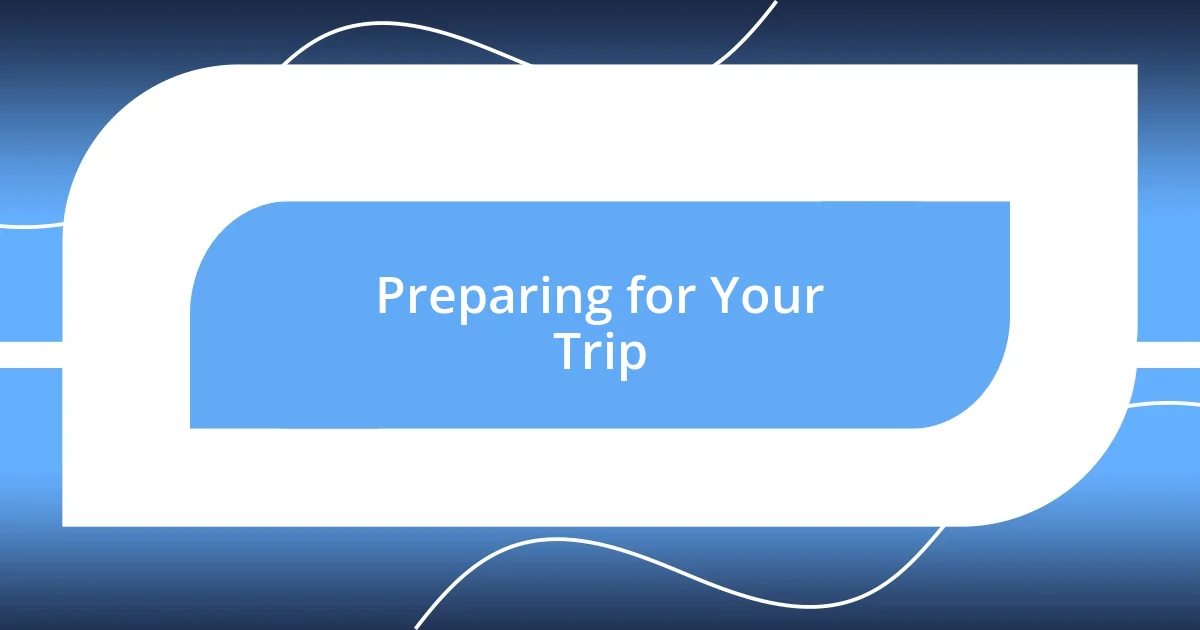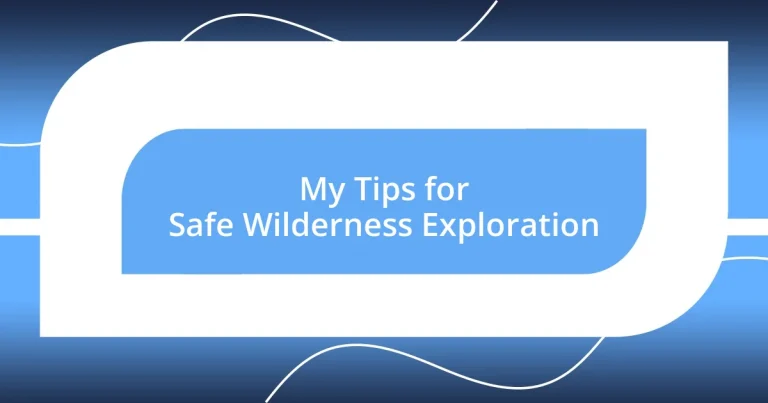Key takeaways:
- Preparation is crucial: Research the area, create an itinerary, and pack essential gear to enhance safety and enjoyment during wilderness trips.
- Navigation skills are vital: Use a map and compass as reliable tools, and practice natural navigation techniques to stay oriented in the wild.
- Respect wildlife and environment: Understand local wildlife hazards, recognize their signs, and practice Leave No Trace principles to preserve nature’s beauty.

Understanding Wilderness Safety
Understanding wilderness safety is more than just knowing how to read a map or navigate with a compass. I remember my first solo hike; I was overly confident and neglected to check the weather. Suddenly, a storm rolled in, and I found myself questioning every decision I’d made. It was a humbling experience that taught me the importance of being prepared for the unexpected.
Another crucial aspect of wilderness safety is understanding the environment. For instance, I’ve come across situations where I underestimated the potential dangers of wildlife encounters. Have you ever stopped to think about how animals behave when they’re startled? During one trip, I startled a mother deer and her fawn. Thankfully, I retreated slowly, remembering that respect for nature keeps both of us safe.
Finally, I’ve learned that staying connected with other people can dramatically enhance your safety in the wild. There have been times when I’ve been off the grid, completely immersed in nature, and I’d feel a wave of anxiety creep in as the sun began to set. I always make sure to let someone know my plans and expected return time. It’s a simple gesture that gives both me and my loved ones peace of mind. Isn’t it comforting to know that a little communication can go a long way in promoting safety?

Preparing for Your Trip
When preparing for a wilderness trip, I like to start with a solid plan. I recall one time when I didn’t take this seriously—I thought I could figure everything out on the go. That led me to waste precious daylight wandering in circles because I had underestimated the terrain. Now, I make it a priority to study maps, understand the route, and check local advice. It’s surprising how empowering it can be to know what to expect.
Here are some key tips to keep in mind when planning your adventure:
– Research the area: Learn about trails, weather patterns, and local wildlife. This knowledge can prevent unpleasant surprises.
– Create a detailed itinerary: Note your starting point, expected stops, and return time, and share this with someone you trust.
– Pack appropriately: Consider the climate, distance, and terrain. Make a checklist to ensure you don’t forget essentials like food, water, and first aid supplies.
– Prepare for emergencies: Familiarize yourself with local emergency contacts and carry a whistle or mirror for signaling help if needed.
– Practice your skills: Spend some time honing navigation or fire-starting techniques before your trip. It builds confidence and ensures you’re ready for anything.
By taking these steps, I find that my trips are much more enjoyable and safe. Isn’t it amazing what a little bit of preparation can do for your peace of mind?

Essential Gear for Wilderness
When venturing into the wilderness, having the right gear can make all the difference. I remember a chilly night when I underestimated the temperature drop. I thought a light sleeping bag would suffice, but I ended up shivering most of the night. Now, I always opt for a sleeping bag suitable for the lowest expected temperatures. The comfort and warmth it provides allows me to rest well, enabling a more enjoyable adventure.
Another critical item on my list is a reliable multi-tool. During one rugged hike, I found myself needing a knife to prepare a meal but had forgotten to pack one. Fortunately, I met an experienced traveler who had a multi-tool handy. It allowed me not only to cook but also proved invaluable when fixing gear later. I’ve since made it a rule to always have a multi-tool with me, as it can address numerous unexpected challenges along the way.
Lastly, don’t overlook the importance of adequate hydration systems. I recall a time I relied solely on a water bottle, which ran dry mid-hike. I felt sluggish and anxious about finding clean water. Now, I use a hydration pack, which keeps my water accessible and encourages me to drink more frequently. Staying hydrated directly impacts my energy and overall mood during wilderness escapades.
| Essential Gear | Description |
|---|---|
| Sleeping Bag | Choose one rated for colder temperatures to ensure warmth. |
| Multi-Tool | A versatile tool for unexpected challenges like cooking or gear repairs. |
| Hydration Pack | Allows easy access to water and promotes regular hydration throughout your hike. |

Navigation Techniques for Safety
When it comes to navigation techniques, I can’t stress enough how crucial it is to embrace the traditional compass and map. I remember one hike where I heavily relied on my phone’s GPS, only to discover the battery died unexpectedly. It was a sinking feeling, being surrounded by dense trees with no idea which direction to head. Now, I always carry a physical map and a compass as my trusty backup. It feels empowering to know I can navigate regardless of technology. Have you ever found yourself relying too much on gadgets?
Incorporating natural navigation skills into your repertoire is also a game-changer. One time, I learned to read landmarks, observing how the moss grows predominantly on the north side of trees in a specific region. It might sound simple, yet this little insight helped me make more informed decisions about my route when I missed the trail. The ability to connect with nature not only adds flair to your navigation but also instills a sense of calm and focus amidst the wilderness chaos.
Lastly, practicing navigation in your local area before heading out can boost your confidence dramatically. I once embarked on a weekend hike near home, intentionally getting lost to test my skills. It was exhilarating to find my way back using only my compass and those landmarks I had memorized. This adventure taught me that navigation isn’t just about reaching a destination—it’s a journey in itself filled with learning moments. So, what are you waiting for? Grab your compass, and let’s head into the wild!

Identifying Wildlife Hazards
Identifying wildlife hazards starts with understanding the types of animals that inhabit the area. I’ll never forget the time I unexpectedly came across a massive bear while hiking. My heart raced as it emerged from behind the trees; luckily, I remembered my basic safety training. I calmly made noise, backed away, and gave it space. That experience drove home the importance of knowing what wildlife might be lurking—especially apex predators like bears or mountain lions.
However, it’s not just large animals that pose a threat. Even smaller creatures, such as snakes or insects, can cause serious harm. Once while backpacking, I brushed against what I thought was a harmless plant, only to realize it was home to a wasp nest. The ensuing swarm was overwhelming, and I got stung multiple times. Ever since that incident, I’ve learned to be more cautious and aware of my surroundings, particularly during warm weather when these hazards are more active.
Signs of wildlife activity can also offer critical insights into the presence of potential hazards. For instance, I once noticed fresh paw prints along a trail, leading me to believe a large animal was nearby. Instead of panicking, I took a moment to assess my options. I chose a different path, allowing me to avoid a potential confrontation. Learning to identify these signs—like tracks, scat, or even chewed vegetation—has empowered me to make safer choices in the wilderness. Have you ever spotted tracks and wondered what kind of adventure awaited? It’s a reminder that staying informed is crucial for a safe and enjoyable experience.

Emergency Response Strategies
Emergency response strategies in the wilderness are vital, and having a solid first aid kit is the first step. I remember a hiking trip where a friend twisted their ankle and we ended up in a remote area with no cell service. Thankfully, I had packed a comprehensive first aid kit, complete with splints and pain relievers. It was intense and stressful, but knowing I had the tools to help made a world of difference. What would you do in a similar situation?
Beyond a first aid kit, communication tools like a whistle or satellite phone can be lifesavers. During one solo trip, I accidentally wandered off the trail and lost track of my bearings. After a brief moment of panic, I remembered my whistle—three sharp blasts could signal for help. The feeling of empowerment in that moment really hit me; even when lost, I had a way to alert others to my situation. How prepared are you to reach out if things don’t go as planned?
Lastly, practicing scenario-based drills can cultivate a sense of readiness. Picture this: a friend and I staged a mock emergency, where one of us pretended to faint on the trail. It felt silly at first, but those few minutes of acting out what we’d do in a real situation taught us so much about quick thinking and teamwork. Have you ever thought of turning learning into a fun activity? Approaching these practices with a playful mindset can transform them into valuable experiences, making it easier to respond effectively in emergencies.

Practicing Leave No Trace Principles
Practicing Leave No Trace principles is essential for preserving the beauty of our wild places. I remember a camping trip where I found a pristine stream nestled in the woods, but it was surrounded by litter from previous visitors. It broke my heart to see the trash in such a beautiful setting. Since then, I’ve made it a point to pack out whatever waste I bring in, and I always carry an extra trash bag. Have you ever considered how small actions can make a big difference in keeping nature clean?
One time, I ventured into a stunning alpine environment, and I was struck by how important it is to stick to existing paths. While walking, I noticed a trail widening from the footsteps of fellow hikers, and it struck me: every deviation contributes to habitat loss. I consciously chose to stay on the marked trail, knowing that each step I take matters. How often do we think about the impact of our footprints on the landscapes we cherish?
When it comes to campfires, I can’t stress enough the value of leaving them behind as you found them. During a backpacking trip, my group decided to enjoy a campfire, but we took special care to use existing fire rings and ensure it was completely out before leaving. The glow of the flames was beautiful, but responsibly managed, it ensures the area remains untouched for future adventurers. It made me wonder: how often do we prioritize the health of the environment while chasing those memorable moments?














